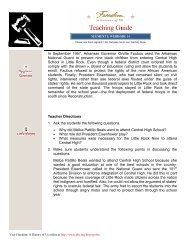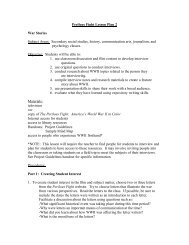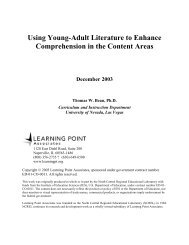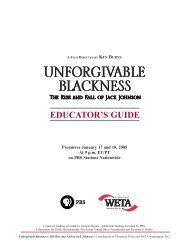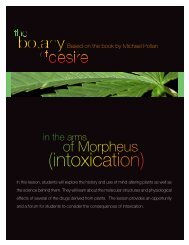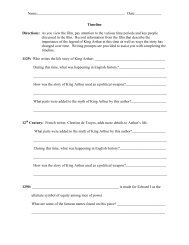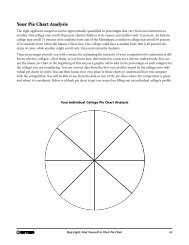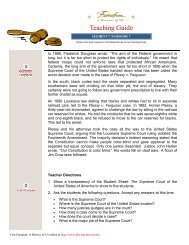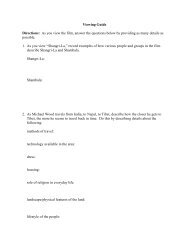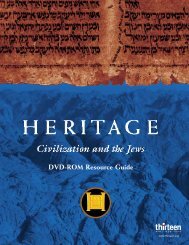Create successful ePaper yourself
Turn your PDF publications into a flip-book with our unique Google optimized e-Paper software.
The Body Changers<br />
There’s no place like<br />
The Secret World of Sharks and Rays<br />
Earth Navigators<br />
Springs Eternal<br />
ocean<br />
rain forest<br />
sea ice<br />
desert<br />
mountains<br />
swamps<br />
coral reefs<br />
plains<br />
steppes<br />
Great White Bear<br />
Obsession with Orchids<br />
PLANKTON BLUE SHARK MONARCH<br />
BUTTERFLY<br />
MANATEE POLAR BEAR ORCHID<br />
Teacher’s Guide<br />
NATURE is produced for <strong>PBS</strong> by Thirteen/WNET New York.<br />
NATURE is made possible in part by Park Foundation. Major corporate support is provided by Canon U.S.A., Inc., Ford Motor Company, and TIAA-CREF. Additional support is provided by the nation’s public television stations.
Dear Friends of NATURE:<br />
Park Foundation is dedicated to education, so we support television programs<br />
that are informative and enriching. We are also deeply concerned about our<br />
environment. It is for these reasons that we are delighted to sponsor<br />
NATURE, the public television series that reveals the beauty and complexity<br />
of life on our planet. NATURE gives teachers and their students the<br />
opportunity to learn more about the many forms of life existing in our world.<br />
This season’s education package offers lessons, activities and research<br />
projects to accompany six NATURE programs—“Obsession with Orchids,”<br />
“Earth Navigators,” “Great White Bear,” “The Body Changers,” “Springs<br />
Eternal: Florida’s Fountain of Youth,” and “The Secret World of Sharks and<br />
Rays.” These programs show how life forms from butterflies to sharks have<br />
adapted to a wide variety of ecosystems. In supporting NATURE, our goal is<br />
to heighten your students’ appreciation and understanding of the world’s<br />
wildlife. We hope that the programs, together with the lessons in this Guide,<br />
will help them see things from a naturalist’s point of view.<br />
Please know we continue to be grateful for your work and are pleased to help<br />
support it.<br />
Trustees<br />
Park Foundation<br />
Park Foundation Inc., P.O. Box 550, Ithaca, New York 14851<br />
Dear Educator:<br />
Canon U.S.A., Inc.<br />
One Canon Plaza<br />
Lake Success, NY 11042-1113<br />
For the tenth consecutive year Canon U.S.A., Inc. is pleased to be a sponsor of the NATURE series and bring<br />
you this Teacher’s Guide.<br />
NATURE brings the wonders of the natural world into our homes in a way that is both compelling and eyeopening.<br />
The six NATURE programs in this Guide will give you and your students new insights into the ways that<br />
animals and plants cope with their surroundings. They show that some creatures survive for millennia in one<br />
place, while others migrate, travelling long distances to reach hospitable environments.<br />
Canon is a company well known for investment in new technology. However, some of our most important<br />
research and development projects have nothing to do with our products. We invest in “future generations”<br />
through the support of a wide variety of programs reaching today’s children and protecting tomorrow’s<br />
environment. It is our belief that a successful business should do more than make a profit; it should make a<br />
difference as well.<br />
Through our Clean Earth Campaign, we work to preserve our natural lands with programs such as “Expedition<br />
Into The Parks” through the National Park Foundation. Additionally, our “Cartridge Recycling Program” keeps<br />
millions of toner cartridges out of landfills, while our line of office equipment is designed to use less energy by<br />
exceeding the Environmental Protection Agency’s ENERGY STAR guidelines. Canon also sponsors the “Canon<br />
Envirothon,” a nationwide high school curriculum and competition that helps students develop an early sense of<br />
environmental responsibility.<br />
We hope this Teacher’s Guide provides you with tools to assist your teaching of the world around us. We salute<br />
your efforts and deeply respect your commitment to America’s “ future generations.” We are honored to play a<br />
part in providing you with materials you may wish to use in preparing your students to better understand<br />
NATURE.<br />
Sincerely,<br />
Dear Educator:<br />
Once again TIAA-CREF is delighted to be a national sponsor of<br />
NATURE, and to help bring its award-winning educational programs and teaching<br />
materials to you and your students.<br />
Kinya Uchida<br />
President & CEO<br />
Canon U.S.A., Inc.<br />
Visit our Web site at www.usa.canon.com<br />
We hope the accompanying Teacher’s Guide will prove stimulating as you and<br />
your students participate in NATURE’s exciting programs on how living things<br />
adapt and thrive in changing environments.<br />
These programs feature a variety of ecosystems and climates, from “Great White<br />
Bear,” which shows a year in the life of polar bears in the Arctic, to “The Secret<br />
World of Sharks and Rays,” which gives students a chance to learn more about<br />
diversity and adaptation among these ocean dwellers.<br />
For over eighty years, TIAA-CREF has recognized the crucial role of the teacher<br />
in our society. We are dedicated to providing pension, investment, and insurance<br />
products that help build financial security for those who choose careers in<br />
education and research.<br />
TIAA-CREF salutes you and your colleagues for your commitment to educating<br />
our youth.<br />
William Clay Ford, Jr.<br />
Chairman of the Board<br />
Dear Educator:<br />
Ford Motor Company<br />
The American Road<br />
P.O. Box 1899<br />
Dearborn, Michigan 48121-1899 USA<br />
I am pleased that Ford Motor Company is bringing you this Teacher’s Guide for NATURE. Teaching young minds<br />
about the environment is a vitally important task. Making the world a better place is an important part of Ford’s view of<br />
the world, and that includes educating the next generation about society’s role in the global ecosystem.<br />
The NATURE series, with its focus on wildlife and natural habitats and their preservation, is an inspiring and exciting<br />
way for children to encounter the environment in the classroom. We are proud to be associated with it.<br />
On behalf of all of us at Ford Motor Company, I salute your work and hope you find these NATURE materials a useful<br />
tool.<br />
Sincerely,<br />
John H. Biggs<br />
Visit our Web site at www.tiaa-cref.org to learn more about how TIAA-CREF is ensuring the future for<br />
those who shape it, or call 1-800-223-1200 for further information.<br />
William Clay Ford, Jr.<br />
For information on vehicles Ford Motor Company has developed to make driving easier on the world around us,<br />
call 1-877-ALT-FUEL (1-877-258-3835, Monday-Friday, 8:00 a.m. to 5:00 p.m. EST), or visit our Web site at www.ford.com.
INTRODUCTION<br />
Living things have adapted to the environment in remarkable ways. Orchids use unusual methods<br />
of pollinating which help them survive in a variety of climates—from rain forests to deserts. Some<br />
animals, like frogs and butterflies, metamorphose as they mature; others migrate for thousands of<br />
miles when the seasons change. This Teacher’s Guide has been developed for use with six programs<br />
from the public television series NATURE—“Obsession with Orchids,” “Earth Navigators,”<br />
“Great White Bear,” “The Body Changers,” “Springs Eternal: Florida’s Fountain of Youth,” and<br />
“The Secret World of Sharks and Rays.” These programs show the many ways animals and plants<br />
have adapted to ecosystems around the world, from the snow-and-ice-covered Arctic to the coral<br />
reefs of the Caribbean.<br />
The Educational Materials<br />
This guide has been designed to help you and your students use the public television series as a<br />
starting point for active participation in the study of nature. Students are encouraged to view the<br />
programs as a naturalist would, observing animals in a variety of habitats, noting their behavior,<br />
and drawing conclusions.<br />
Each lesson in the Teacher’s Guide includes:<br />
Program Overview, which gives background information and a brief synopsis of the program to<br />
be viewed;<br />
Objectives, which provide measurable goals;<br />
Before Viewing Activity, familiarizing students with the subject and allowing them to set purposes<br />
for viewing;<br />
Program Scheduling<br />
Programs are scheduled to be<br />
broadcast on the dates indicated<br />
below. Broadcast dates, however,<br />
may vary slightly from area to area.<br />
Please check local listings for any<br />
scheduling changes.<br />
Program Broadcast Dates<br />
Obsession with Orchids April 16<br />
Earth Navigators April 23<br />
Great White Bear April 30<br />
The Body Changers May 7<br />
Springs Eternal May 14<br />
The Secret World of<br />
Sharks and Rays May 21<br />
NATURE Web Sites and<br />
wNetSchool<br />
Look for more information about<br />
NATURE on the Web at<br />
www.pbs.org or at<br />
www.thirteen.org. These lessons<br />
can also be found on wNetSchool<br />
(www.thirteen.org/wnetschool).<br />
Videotaping Rights<br />
Vocabulary, which provides definitions of unfamiliar words used in each program;<br />
Discussion Questions that help students assess the main points of the program;<br />
Suggested Resources for students who may want to learn more about the topic; and<br />
Student Worksheet (Naturalist’s Guide), to be duplicated and distributed in class. This worksheet<br />
contains activities that will help students gain a better understanding of animal behavior,<br />
natural phenomena, and other subjects discussed in NATURE programs. The worksheets encourage<br />
family viewing and contain a number of creative activities.<br />
O B J E C T I V E S<br />
While these materials encourage home viewing, you may choose to focus on segments of a program<br />
in class. If you use this approach, we recommend that you tape and preview the program to<br />
find segments that relate to the discussion questions and student worksheet.<br />
Creating a Naturalist’s Diary (You may wish to share the following with your students):<br />
Naturalists keep diaries to record their observations. Students may be interested in making<br />
diaries of their own. Students may set aside part of their science notebook, or they may choose to<br />
make a separate booklet for this purpose. Diaries may include news clippings, drawings, photos,<br />
maps, charts, graphs, and other information, as well as records of observations. Students may<br />
share their diaries with others or use their entries to develop a bulletin board display that reflects<br />
what they have learned.<br />
You may assign programs to your<br />
students for viewing when they are<br />
first broadcast, or you have the<br />
right to tape the programs and play<br />
them for instructional purposes for<br />
one year after the original broadcast.<br />
Table of Contents<br />
Introduction 1<br />
Obsession with Orchids 2<br />
Earth Navigators 4<br />
Great White Bear 6<br />
The Body Changers 8<br />
Springs Eternal 10<br />
The Secret World of Sharks<br />
and Rays 12<br />
NATURE Schedule Back Cover<br />
Video Ordering<br />
Information<br />
Back Cover<br />
1
PROGRAM<br />
Obsession with Orchids<br />
BROADCAST DATE APRIL 16, 2000<br />
BBC/Tim Shepherd 1998<br />
With over 20,000<br />
species, orchids are one<br />
of the largest groups of<br />
plants on Earth.They<br />
grow in virtually every<br />
habitat, from mountain peaks<br />
to rain forests, from deserts to<br />
meadows.When it comes to unusual<br />
pollination methods, orchids possess<br />
remarkable flower power.<br />
For orchids to reproduce, pollen from<br />
the male part of one flower must reach<br />
the female part of another flower. Unlike<br />
most plants, where the pollen is dustlike<br />
and freely released, in orchids,<br />
pollen is located in pollen sacs.<br />
Delivering these sacs to another flower<br />
requires the help of insects and other<br />
animals. For example, moths are<br />
attracted by the pyramidal orchid’s<br />
bright colors.When the moth drinks the<br />
orchid’s sugary nectar, the flower’s<br />
pollen sacs attach themselves to the<br />
insect’s tongue. Amazingly, the only<br />
thing that can remove the pollen sacs<br />
from its tongue is another pyramidal<br />
orchid.<br />
BEFORE VIEWING THE PROGRAM<br />
Ask students if they or their relatives are allergic to<br />
pollen, and, as a result, spend much of the springtime<br />
sneezing. Help students understand what pollen is (see<br />
Vocabulary) and the role it plays in flower reproduction.<br />
If possible, let students observe pollen on an actual<br />
flower. You may wish to point out the similarities<br />
between the words “pollen” and “pollination.”<br />
Explain that, unlike most animals, each orchid has both<br />
male and female reproductive organs. In order for<br />
flowers to reproduce, the pollen from one flower needs to<br />
reach another of the same type of flower. Since flowers<br />
can’t walk (except, of course, in science-fiction movies),<br />
they need to trick insects or small birds to deliver the<br />
pollen for them.<br />
Encourage students to brainstorm a list of some of the<br />
different ways that a flower might attract an insect.<br />
Write all suggestions on the board. Tell students that<br />
one type of flower — orchids—is unusually well-adapted<br />
for attracting insects and birds. Explain that scientists<br />
estimate there are over 20,000 kinds of orchids in the<br />
world. Show some strikingly different photographs of<br />
orchids. Orchids’ thriving numbers stem from their<br />
diverse and successful methods of pollination.<br />
Distribute the Student Worksheet (Naturalist’s Guide)<br />
AFTER VIEWING THE PROGRAM<br />
Encourage students to discuss the program and share<br />
their observations. The following questions may be used<br />
for discussion.<br />
1) What are some ways that orchids attract animals to help<br />
them pollinate?<br />
(Orchids use different “advertisements” to attract their<br />
partners in pollination. Some orchids have bright colors,<br />
others resemble insect species, while still others emit<br />
odors that insects find irresistible. Some orchids have<br />
elaborate traps containing pools of slimy liquid. As an<br />
insect escapes this liquid, the flower’s pollen sacs<br />
become attached.)<br />
2) What is special about orchid pollen?<br />
(Most flowers’ pollen is loose, sticky dust released into<br />
the air. In the case of orchids, the pollen is usually in<br />
two small sacs, each of which contains millions of pollen<br />
grains.)<br />
3) How do orchids reproduce?<br />
(An insect or another small animal accidentally picks up<br />
the pollen from the male part of one orchid, and then<br />
accidentally delivers it to the female part of another<br />
orchid. The insects, unaware of what they’re doing, are<br />
attracted to the flower in hopes of consuming its nectar<br />
or getting another reward.)<br />
In the forests of Central America, some<br />
orchids use fragrant oils to attract<br />
insects. Male euglossine bees, for<br />
example, need an orchid’s unctuous<br />
perfume to attract female bees.When<br />
the male bees land on these flowers,<br />
they slip on the slimy oil and must crawl<br />
out through the flower’s mouth. As the<br />
bee escapes, the orchid’s pollen sacs<br />
become attached to its body.They will<br />
not be removed until this bee falls into<br />
another orchid of the same kind, and<br />
then climbs out.<br />
This program also explores the human<br />
fascination with orchids, and to what<br />
lengths people will go to possess them.<br />
In addition, it shows how we have<br />
learned the art of hybridization—<br />
crossing the color and/or shape of one<br />
flower with that of another.<br />
THEME: Orchids flourish in tremendous<br />
variety throughout most of the natural<br />
world because they have clever<br />
adaptations for pollination.<br />
2<br />
Photocopy and hand out the student worksheet<br />
(Naturalist’s Guide) on the opposite page, and preview it<br />
with students. As they watch the program, ask them to<br />
look for examples of how orchids attract insects and<br />
other creatures to help in pollination.<br />
O B J E C T I V E S<br />
Students will:<br />
• understand the basics of pollination, the process by<br />
which flowers reproduce<br />
• observe how some orchids have adapted to attract<br />
various animals in order to be pollinated<br />
• discuss how humans have learned to hybridize<br />
orchids<br />
VOCABULARY<br />
fungi: (pl. of fungus): plants that have no leaves,<br />
flowers, or roots; mushrooms, for example<br />
hybridization: when someone artificially “mates” one<br />
type of flower with another, creating a new type of<br />
flower that combines the parent flowers’ colors and<br />
shapes<br />
pollen: tiny grains in a flower that contain the plant’s<br />
male reproductive cells<br />
pollination: the process by which flowers are fertilized;<br />
to transfer the pollen from the stamen (male<br />
flower part) to the pistil (female flower part), so<br />
seeds can be produced<br />
propagate: to reproduce a species of plant or animal<br />
SUGGESTED RESOURCES<br />
Books<br />
Pridgeon, Alec. The Illustrated Encyclopedia of<br />
Orchids. Portland, Oreg.: Timber Press, 1992.<br />
Schoser, Gustav. Orchid Growing Basics. New York:<br />
Sterling Publishing, 1993.<br />
4) Why have orchids evolved in such diversity?<br />
(There are over 20,000 species of orchids because these<br />
flowers are able to adapt to a wide variety of<br />
environments, from rain forests to high mountains, from<br />
meadows to deserts.)<br />
Web Sites<br />
The American Orchid Society<br />
http://www.orchidweb.org/welcome/about.html<br />
The Orchid Weblopedia<br />
http://conbio.bio.uci.edu/orchid<br />
The Orchid Photo Page<br />
http://www.orchidworks.com<br />
Linda’s Orchid Page – A Guide to Anatomy<br />
http://www.orchidlady.com/anatomy.html<br />
Orchid Mania’s Virtual Greenhouse (raises money for<br />
AIDS organizations)<br />
http://www.orchids.org<br />
Orchid Forum – message board for orchid-related<br />
topics<br />
http://www.gardenweb.com/forums/orchids
NATURALIST’S GUIDE<br />
STUDENT WORKSHEET Obsession with Orchids<br />
a Thirteen NATURE program<br />
Complete the first activity and one other activity of your choice.<br />
ANATOMY OF AN ORCHID<br />
This program features dozens of attractive orchids<br />
from around the world. Although these stunning flowers<br />
come in many different colors and shapes, they<br />
all share some common features.<br />
All orchids have three petals. The lower petal,<br />
called a lip or labellum, serves as a platform<br />
for insects who unintentionally deliver pollen<br />
from one flower to another. Orchids also have<br />
three petal-like sepals, which are actually<br />
the remains of the flower bud. In the center<br />
of an orchid is a finger-like part called the<br />
column. The column carries the flower’s<br />
male and female reproductive organs, the<br />
pollen-producing stamen (male) and the eggproducing<br />
pistil (female).<br />
Find three photographs of different orchids.<br />
See if you can label the parts of these flowers<br />
using the information from this orchid.<br />
Dorsal sepal<br />
Column (includes<br />
stamen & pistil)<br />
Lip<br />
Petal<br />
Lateral sepal<br />
TO THE FAMILY<br />
You are invited to watch<br />
NATURE. After you watch<br />
this program, visit a<br />
botanical garden or floral<br />
shop in your community to<br />
observe and compare a<br />
variety of flowers. See if<br />
you can find the pollen on<br />
these flowers.<br />
Photos (clockwise from top right): BBC/Tim Shepherd 1998, Rod Planck/ Photo Researchers, Inc.,<br />
Animals Animals/© J.A.L. Cooke/OSF, Scott Camazine/ Photo Researchers, Inc.<br />
VISIT A BOTANICAL GARDEN<br />
It’s one thing to study orchids on video or in a book.<br />
It’s quite another to see real ones close-up. Use library<br />
resources or a phone book to find a botanical garden<br />
or florist in your area. Help organize a class field trip.<br />
As an alternative, contact the botany department of a<br />
local university about inviting a guest speaker to come<br />
to your class to discuss how their scientists study<br />
orchids and other flowers.<br />
These materials were made possible by Park Foundation, Canon U.S.A., Inc., Ford Motor Company, and TIAA-CREF.<br />
WHAT IF THEY MATED?<br />
A horticulturist is someone who studies the art<br />
and science of growing plants and flowers. Some<br />
horticulturists have learned to create new kinds<br />
of orchids using a process called hybridization.<br />
On the “What if they Mated” Web site,<br />
www.orchidworks.com/orchids/what_if/intro.htm,<br />
you can virtually experiment combining different<br />
kinds of orchids with each other.
PROGRAM<br />
Earth Navigators<br />
BROADCAST DATE APRIL 23, 2000<br />
© Partridge Films<br />
4<br />
Each year, as Earth orbits the<br />
Sun, the seasons change.<br />
These changes affect<br />
climate and food supply<br />
and cause various<br />
animals to migrate<br />
from one part of the<br />
globe to another. Some<br />
animals, such as<br />
wildebeests and salmon,<br />
travel for most of their lives.<br />
This program follows the yearly<br />
migrations of four animals: a bird, a<br />
mammal, an insect, and a fish.<br />
The program begins on the first day of<br />
spring in the northern hemisphere. In<br />
the mountains of Mexico, millions of<br />
monarch butterflies prepare to fly<br />
north, across the United States to<br />
Canada.This journey takes these<br />
butterflies several generations to<br />
complete. Each generation instinctively<br />
knows where to fly next. In Alaska,<br />
sockeye salmon hatch.The rivers swell<br />
and these salmon are swept downstream<br />
toward the Bering Straits between<br />
Alaska and Siberia. Also during spring, in<br />
the marshlands of <strong>No</strong>rfolk, England,<br />
numerous whooper swans get ready to<br />
fly northward toward the Arctic.<br />
During the summer in Africa, as the wet<br />
season ends in the Serengeti, herds of<br />
wildebeest travel in order to find fresh<br />
grazing.Their migration takes them in a<br />
giant, clockwise circle, during which they<br />
will face many predators, such as lions<br />
and crocodiles.<br />
How do these animals travel to<br />
migratory destinations thousands of<br />
miles away and not get lost? Scientists<br />
hypothesize that the animals, through<br />
evolution, know how to read nature’s<br />
signals, such as the changing positions of<br />
the Sun during the day and the stars at<br />
night. Scientists also think that some<br />
animals can tell direction by sensing<br />
Earth’s magnetic field.<br />
THEME: In response to Earth’s changing<br />
seasons, different animals have adapted<br />
with migratory behaviors that help them<br />
survive.<br />
BEFORE VIEWING THE PROGRAM<br />
Ask students: “What causes the change in seasons?” After<br />
some discussion, explain that the change in seasons has to<br />
do with Earth’s annual trip around the Sun.<br />
Use a large beach ball and a globe to represent the Sun<br />
and the Earth. Ask a student to hold the beach ball (Sun).<br />
Have another student hold the globe perpendicular to the<br />
plane of Earth’s orbit around the Sun (with the <strong>No</strong>rth Pole<br />
pointing directly up to the ceiling). Ask the student holding<br />
the globe to walk slowly in a small circle around the<br />
Sun, spinning the globe and keeping the Earth’s axis<br />
straight. Explain that if Earth’s orbit were like this, there<br />
would be no seasons—everyplace on Earth would always<br />
have 12 hours of sunlight and 12 hours of darkness.<br />
Explain that Earth’s axis is always tilted at an angle of<br />
approximately 23°, so depending on the time of year, the<br />
different hemispheres get different amounts of daylight.<br />
During winter in the northern hemisphere, the Sun sets<br />
earlier and it gets colder than in other seasons, even<br />
though the Earth is actually closer to the Sun than it is in<br />
summer. What makes it so cold, then? During winter, rays<br />
from the Sun reach the northern hemisphere at an angle,<br />
making the temperature colder than in summer, when the<br />
rays are direct.<br />
Before watching the program, make sure students understand<br />
the meaning of the word “migration” and can think<br />
of at least one example of a migratory animal. Tell students<br />
that many animals move from one place to another<br />
in response to seasonal changes, such as the amount of<br />
sunlight in a day. Point out that migration is an important<br />
behavioral adaptation.<br />
O B J E C T I V E S<br />
Students will:<br />
• observe how the change in seasons causes some<br />
animals to migrate<br />
• recognize that migration is an evolutionary adaptation<br />
for survival<br />
• compare the migration behaviors of different animals<br />
VOCABULARY<br />
imprinting: an instinctual bond that forms rapidly<br />
between some baby animals and their parents (or a<br />
substitute)<br />
instinct: an inborn pattern of behavior<br />
migration: moving annually or seasonally from one<br />
location to another in search of food or to reach breeding<br />
areas<br />
spring equinox: usually March 20, one of two times each<br />
year when everywhere on Earth gets exactly 12 hours of<br />
daylight<br />
summer solstice: usually June 22, the longest day in the<br />
northern hemisphere and is when the Arctic has continual<br />
sunlight<br />
autumnal equinox: usually September 23, one of two<br />
times each year when everywhere on Earth gets exactly 12<br />
hours of daylight<br />
winter solstice: usually December 22, the shortest day in<br />
the northern hemisphere<br />
SUGGESTED RESOURCES<br />
Books<br />
Distribute the Student Worksheet (Naturalist’s Guide)<br />
Photocopy and hand out the student worksheet<br />
(Naturalist’s Guide) on the opposite page, and preview it<br />
with students. As they watch the program, encourage<br />
them to compare the migration behaviors of different<br />
animals presented in the program.<br />
AFTER VIEWING THE PROGRAM<br />
Encourage students to discuss the program and share<br />
their observations. The following questions may be used<br />
for discussion.<br />
1) Why is it so important that young whooper swans imprint<br />
on their parents?<br />
(Young swans that successfully imprint automatically<br />
follow their parents on the migration route, so they won’t<br />
get lost and will learn the route themselves.)<br />
2) When the winds blow a monarch butterfly to England,<br />
why does the program’s narrator predict that it won’t<br />
survive?<br />
(Monarch butterflies rely on the milkweed plant to<br />
survive. Unfortunately, the milkweed plant doesn’t grow<br />
in England.)<br />
3) According to biologists’ theories, what are some of the<br />
methods that the animals in this program use to navigate<br />
across great distances?<br />
(Whooper swans instinctively use the position of the Sun<br />
and the stars to fly to and from the Arctic. Salmon are<br />
able to locate the gravel beds in which they were born<br />
by smelling and tasting the water. Many scientists<br />
believe that butterflies, gray whales, and other creatures<br />
somehow use Earth’s magnetic field to help them reach<br />
their destinations.)<br />
Riha, Susanne. Animal Journeys: Life Cycles and<br />
Migrations. Woodbridge, Conn.: Blackbirch Press, 1999.<br />
Simon, Seymour. They Swim the Seas: Mysteries of Animal<br />
Migration. San Diego: Browndeer Press, 1998.<br />
Stone, Lynn M. The Wildebeest’s Great Migration. Vero<br />
Beach, Fla.: Rourke Corp., 1991.<br />
Web Sites<br />
Journey <strong>No</strong>rth<br />
http://www.learner.org/jnorth<br />
Monarch Butterfly Watch<br />
http://www.monarchwatch.org<br />
For the Sake of Salmon - Teacher Materials<br />
http://www.4sos.org/teach_mat/teachers.html<br />
Animal Bytes: Wildebeest<br />
http://www.seaworld.org/animal_bytes/wildebeestab.html
NATURALIST’S GUIDE<br />
STUDENT WORKSHEET Earth Navigators<br />
a Thirteen NATURE program<br />
Complete the first activity and one other activity of your choice.<br />
MAKE A MIGRATION MAP<br />
Gulf<br />
of<br />
Alaska<br />
CANADA<br />
Hudson<br />
Bay<br />
Labrador<br />
Sea<br />
60°<br />
Imagine you have been hired to create an<br />
exhibit for a children’s science museum that<br />
teaches other kids about animal migration<br />
patterns. Draw a large, simplified map<br />
showing the monarch butterfly’s migratory<br />
path, and on separate pieces of paper,<br />
draw, color, and label small pictures of the<br />
butterfly. Then put Velcro dots or strips (or<br />
tape loops) behind each of the drawings so<br />
that they stick to the map but can easily be<br />
moved. Write instructions that ask visitors to<br />
guess where the butterfly lives during<br />
different seasons.<br />
Pacific<br />
Ocean<br />
0 500 1000 mi<br />
0 500 1000 km<br />
150° 120°<br />
UNITED STATES<br />
Gulf<br />
of Mexico<br />
BAHAMAS<br />
MEXICO<br />
CUBA<br />
BELIZE JAMAICA<br />
Caribbean Sea<br />
GUATEMALA HONDURAS<br />
NICARAGUA<br />
EL SALVADOR<br />
90°<br />
COSTA PANAMA<br />
RICA<br />
Atlantic<br />
Ocean<br />
TURKS<br />
& CAICOS<br />
PUERTO<br />
RICO<br />
60°<br />
30°<br />
Map courtesy of Magellan Geographix, Santa Barbara, CA (805) 685-3100 in conjunction with Maps101.com<br />
Photo: Animals Animals/© A. & M. Shah<br />
ON THE GO<br />
Create a large poster chart that will help other<br />
students in your class compare the different<br />
migration behaviors presented in “Earth Navigators.”<br />
Across the top of the chart, list the names of<br />
animals from this program. Along the side of the<br />
chart, write the following questions:<br />
• What do they eat?<br />
• What seasonal changes trigger their migration?<br />
• How often do they migrate?<br />
• How do they navigate to where they’re going?<br />
• How long does their migration journey take?<br />
These materials were made possible by Park Foundation, Canon U.S.A., Inc., Ford Motor Company, and TIAA-CREF.<br />
GET THOSE BINOCULARS!<br />
Find out what wildlife migrates through your<br />
area each year. To help your research,<br />
contact a conservation organization such as<br />
the National Audubon Society [700 Broadway;<br />
New York, NY 10003. Phone: (212) 979-3000;<br />
fax: (212) 979-3188; http://www.audubon.org].<br />
You can also help a group called Journey<br />
<strong>No</strong>rth track species as they migrate across<br />
the northern hemisphere. By identifying<br />
migratory animals, you can help scientists<br />
study how seasons influence wildlife. This<br />
organization also provides online images of<br />
animals as they migrate. Their Web address<br />
is www.learner.org/jnorth. You may also<br />
contact your state Fish and Wildlife<br />
Department for state and regional migration<br />
counts.<br />
TO THE FAMILY<br />
You are invited to watch<br />
NATURE together as a<br />
family. As you view this<br />
program, you may wish to<br />
point out that seasonal<br />
changes cause some<br />
humans to travel, too,<br />
but for different reasons.<br />
Contact a local wildlife<br />
organization to find out<br />
what animals travel<br />
through your area.
PROGRAM<br />
Great White Bear<br />
BROADCAST DATE: APRIL 30, 2000<br />
Animals Animals/© Johnny Johnson<br />
6<br />
Despite its reputation as an icy<br />
wasteland, the Arctic goes<br />
through seasons. In the<br />
winter darkness, bitter<br />
cold temperatures<br />
cause the ocean surface<br />
to freeze. During<br />
summertime, continual<br />
sunlight melts the<br />
ocean’s pathways. Changes<br />
in climate naturally affect<br />
how Arctic animals search for food.This<br />
program follows the struggles and<br />
successes of the polar bear, the world’s<br />
largest land carnivore, over the span of a<br />
year.<br />
This program starts in the spring, as a<br />
mother polar bear and her cubs emerge<br />
from hibernation in search of food. As<br />
she searches for seals to feed her family,<br />
the mother must be wary of the larger<br />
adult male polar bears that could easily<br />
harm her pups. Polar bears are excellent<br />
hunters, due to their acute sense of<br />
smell, keen eyesight, strength, stealth,<br />
and swimming skill. In fact, the polar<br />
bear spends so much time in the ocean<br />
that it can be considered a sea mammal.<br />
Young cubs live with their mother for<br />
two and a half years. During this time,<br />
they learn important survival skills, such<br />
as hunting, fighting, and scavenging.<br />
Although polar bears are skilled<br />
hunters, when food is scarce, they rely<br />
on a remarkable adaptation. In lean<br />
times, polar bears have the ability to<br />
reduce their metabolism in order to<br />
save energy.To supplement a diet of<br />
marine animals, polar bears sometimes<br />
consume plants, such as seaweed and<br />
berries.<br />
THEME: In the Arctic, the polar bear’s<br />
search for food adjusts in response to<br />
the seasons.<br />
BEFORE VIEWING THE PROGRAM<br />
Announce that the program students will be seeing is<br />
about the largest land carnivore in the world. After<br />
clarifying what a carnivore is (see Vocabulary on this<br />
page), invite them to guess what animal the show is about.<br />
Write all hypotheses on the board. As you give the answer,<br />
point to the photograph of the polar bear on the poster<br />
that accompanies this guide. Many students will probably<br />
be surprised to learn that the largest land carnivore<br />
doesn’t live in Africa but in the Arctic. (Remind students<br />
that while elephants are larger than polar bears, they are<br />
herbivores, not carnivores.) Explain that the adult male<br />
polar bear can become as heavy as 1,500 lbs.<br />
Ask students to identify the Arctic on a globe. Once<br />
students clarify what climate means, help them predict<br />
what the Arctic climate is like in different seasons. To<br />
start, you may wish to ask students to use what they know<br />
about climate changes in your area during the different<br />
seasons. Do they think the climate in the Arctic is the<br />
same year-round? Encourage them to support their<br />
arguments based on what they know about earth science<br />
(e.g., Earth’s tilted axis and orbit around the Sun).<br />
Discuss a polar bear’s diet. Explain that except when<br />
pregnant females are in hibernation, polar bears are<br />
almost always searching for food. Ask students to guess<br />
what a polar bear’s favorite meal is. (See photo and<br />
caption about the ringed seal.) Invite students to make<br />
predictions about the different ways polar bears hunt in<br />
the winter (when there’s 24 hours of darkness) and in the<br />
summer (when there’s continual sunlight, and much of the<br />
ice melts into the ocean).<br />
Distribute the Student Worksheet (Naturalist’s Guide)<br />
Photocopy and hand out the student worksheet<br />
(Naturalist’s Guide) on the opposite page, and preview it<br />
OBJECTIVES<br />
Students will:<br />
• observe the interdependence of plants and animals<br />
of the Arctic<br />
• analyze how the polar bear’s anatomy helps it<br />
survive<br />
• observe how polar bears catch their prey<br />
• discuss how seasonal changes affect wildlife in<br />
the Arctic<br />
VOCABULARY<br />
adaptation: a physical characteristic or behavior in<br />
animals or plants that helps their survival; caused by<br />
millions of years of evolution<br />
carnivore: an animal that eats mostly meat<br />
carcass: the body of a dead animal; what scavengers<br />
look for<br />
climate: typical weather pattern for a certain area of<br />
the world<br />
metabolism: the process by which food is converted<br />
into energy in a living body<br />
predator: an animal that hunts other animals for food<br />
prey: an animal that is hunted by a predator for food<br />
with students. As they watch the program, encourage<br />
students to pay special attention to information about<br />
the polar bear’s anatomy and search for the answers to<br />
the questions posed on the worksheet.<br />
AFTER VIEWING THE PROGRAM<br />
Encourage students to discuss the program and share<br />
their observations. The following questions may be used<br />
for discussion:<br />
1) What are some of the different methods polar bears use<br />
to hunt for food?<br />
(Hunting methods include: sneaking up on prey both in<br />
water and on land, sniffing out prey from up to a mile<br />
away, hiding behind snow, then pouncing on prey,<br />
swatting prey with their paws.)<br />
2) What skills do young polar bear cubs need to learn in<br />
order to survive in the Arctic?<br />
(In order to survive as adults, cubs need to learn how to<br />
stalk seals hiding in snowdrifts. Male cubs need to “play<br />
fight,” so that they can safely determine the pecking<br />
order in their group, and avoid serious injury during an<br />
actual battle.)<br />
3) Why can the polar bear be considered a sea mammal?<br />
(Polar bears are extremely well-adapted for life in the<br />
water. Their mighty arms and legs, webbed feet, and<br />
“waterproof” fur enable them to swim for over fifty miles<br />
at a time in the chilly ocean.)<br />
4) What time of year do you think it is hardest for polar<br />
bears to find food? Why?<br />
(In the summer, when the ice melts, it is a challenge for<br />
polar bears to hunt seals, their favorite meal. At such<br />
times, they sometimes get by eating bird carcasses and<br />
plants.)<br />
SUGGESTED RESOURCES<br />
Books<br />
Kenny, David et al. Klondike and Snow: The Denver<br />
Zoo’s Remarkable Story of Raising Two Polar Bear<br />
Cubs. Niwot, Colo.: Roberts Rinehart, 1995.<br />
Patent, Dorothy Hinshaw. Great Ice Bear: The Polar<br />
Bear and the Eskimo. New York: William Morrow,1999.<br />
Web Sites<br />
Arctic Wildlife Portfolio (Smithsonian Institution)<br />
http://www.mnh.si.edu/arctic/html/wildlife.html<br />
Polar Bears Alive<br />
http://www.polarbearsalive.org
STUDENT WORKSHEET Great White Bear<br />
BUILT FOR THE<br />
ARCTIC<br />
Answer as many of<br />
these questions as you<br />
can on a separate sheet<br />
of paper.<br />
How<br />
does the polar<br />
bear’s weight<br />
change during the<br />
summer? How<br />
does the bear’s<br />
body shape help<br />
it swim?<br />
NATURALIST’S GUIDE<br />
a Thirteen NATURE program<br />
Complete the first activity and one other activity of your choice.<br />
What is the<br />
advantage of<br />
polar bears<br />
having small<br />
ears?<br />
Did You Know?<br />
Photos (clockwise from top right): Animals Animals/© Johnny Johnson, Carleton Ray/ Photo<br />
Researchers, Inc., Animals Animals/ © Gerard Lacz, Animals Animals/© Johnny Johnson<br />
The<br />
hairs that<br />
make up the polar<br />
bear’s fur are hollow.<br />
Why does this keep<br />
the bear warmer<br />
than if these<br />
hairs were<br />
solid?<br />
DONALD BEAR?<br />
Why<br />
is it important<br />
for a polar<br />
bear to fatten<br />
up as winter<br />
arrives?<br />
How<br />
are polar<br />
bears’ feet adapted<br />
for swimming<br />
long distances? How<br />
do their paws prevent<br />
them from<br />
slipping on the<br />
ice?<br />
Polar bears and ducks both have<br />
webbed feet, a useful adaptation for<br />
swimming quickly. Bears share<br />
adaptations with other animals, too.<br />
Make a chart with at least three<br />
columns. At the top of each column,<br />
list another bear adaptation, such<br />
as hollow fur hairs, keen sense of<br />
smell, and so on. Then, below each<br />
adaptation, write the names and<br />
sketch pictures of other animals that<br />
share a similar adaptation.<br />
These materials were made possible by Park Foundation, Canon U.S.A., Inc., Ford Motor Company, and TIAA-CREF.<br />
How<br />
are the<br />
bear’s eyes<br />
adapted for<br />
the Arctic<br />
Sun?<br />
How<br />
far away<br />
can a polar<br />
bear smell?<br />
TRY YOUR HAND AT “POLAR-TRY“<br />
Write a poem about observing animals in the Arctic<br />
during the spring, summer, fall, and winter. Using<br />
observations from the program, as well as research<br />
in the library, describe some of the sights as if you<br />
were in the Arctic at different times of the year. For<br />
example, in your poem, you could tell about a young<br />
polar bear learning to hunt seals from its mother.<br />
Your poem can be playful, but make sure the animal<br />
behavior you describe is accurate. The poem can be<br />
a haiku, a limerick, a series of couplets, or in free<br />
verse. A haiku is three lines of poetry with a certain<br />
number of syllables in each line: 5-7-5. A limerick is<br />
a rhymed, humorous poem of five lines. Couplets<br />
are pairs of rhyming lines, and free verse is a poem<br />
that has no particular pattern or rhyme.<br />
→<br />
The polar bear’s favorite<br />
prey, the ringed seal, lives<br />
mostly beneath the Arctic<br />
Ocean. To breathe, it<br />
creates small holes in the<br />
ice with its strong claws,<br />
and uses its snout to reopen<br />
these “breathing holes”<br />
when they freeze over.<br />
While raising their pups,<br />
mother seals usually hide in<br />
the shelter of snowdrifts. But<br />
sometimes polar bears can<br />
still sniff them out!<br />
TO THE FAMILY<br />
You are invited to watch<br />
NATURE. As you watch<br />
this program on polar<br />
bears, discuss how these<br />
magnificent animals<br />
search for food in the<br />
Arctic. If possible, go to<br />
a nearby zoo to observe a<br />
polar bear close-up.<br />
Discuss the ways that a<br />
polar bear’s life in captivity<br />
is different than in<br />
the wild.
PROGRAM<br />
The Body Changers<br />
BROADCAST DATE: MAY 7, 2000<br />
© Partridge Films<br />
Caterpillars, tadpoles, and salamanders<br />
all share an important trait.<br />
At some point during<br />
their lives, their bodies<br />
transform.Through an<br />
almost magical<br />
metamorphosis, they<br />
change shape, color,<br />
and/or behavior.This<br />
program explores a<br />
variety of animal<br />
transformations and proposes theories<br />
for why they occur.<br />
Through “morphing” animation, viewers<br />
can observe an amazing transformation<br />
—a tadpole turning into a frog.When<br />
environmental factors change quickly,<br />
such as when a pond evaporates,<br />
tadpoles are able to accelerate their<br />
transformation process. If necessary,<br />
they can go from tadpole to frog in less<br />
than a week!<br />
When the caterpillar (larva stage)<br />
becomes a pupa inside a chrysalis, some<br />
organs dissolve as new ones are built.<br />
When the transformation is complete,<br />
an adult butterfly emerges. In an equally<br />
dramatic switch, a dragonfly changes<br />
from a slick, tadpole-eating nymph into<br />
a flying insect that, ironically, is<br />
sometimes eaten by adult frogs.<br />
BEFORE VIEWING THE PROGRAM<br />
Show students ten different close-up photos taken from a<br />
family album or from magazines (one person per picture, a<br />
wide range of ages). Ask two student volunteers to arrange<br />
the photos in order from youngest to oldest. As a class,<br />
discuss whether these students’ proposed order is correct.<br />
Why or why not? What physical clues inform how old a<br />
person is? What characteristics differentiate a baby and an<br />
80-year-old?<br />
Explain that some animals change so much from baby to<br />
adult that they seem to be entirely different. Show a<br />
picture of a butterfly. Ask students to identify what this<br />
animal probably looked like soon after it was born. Most<br />
students will know the butterfly used to be a caterpillar.<br />
Then show a picture of a frog and its earlier stage, a<br />
tadpole. How are they alike and different? Explain that the<br />
video they’ll be seeing, “The Body Changers,” shows a<br />
number of animals that change their appearance, shape,<br />
and behavior. Discuss: What do you think are some<br />
reasons animals transform? How do these changes benefit<br />
their survival?<br />
Distribute the Student Worksheet (Naturalist’s Guide)<br />
Photocopy and hand out the student worksheet<br />
(Naturalist’s Guide) on the opposite page, and preview it<br />
with students. As they watch the program, encourage them<br />
to use the chart to help them compare the transformations<br />
of the different animals in the program.<br />
AFTER VIEWING THE PROGRAM<br />
Encourage students to discuss the program and share<br />
their observations. The following questions may be used<br />
for discussion.<br />
1) How does changing color, shape, and behavior help<br />
some animals?<br />
(These changes help different animals in different ways.<br />
For example, physical transformations can help them<br />
find food, travel to other territories with more food or a<br />
better climate, or appear more appealing to a mate. The<br />
changes can also help them communicate better, and<br />
hide from predators.<br />
2) In the Arizona desert, how do ants and caterpillars help<br />
each other? How does this relationship change once<br />
caterpillars become butterflies?<br />
(The ants and caterpillars in this program both live in<br />
acacia trees. The ants serve as bodyguards for the<br />
caterpillars. In turn, the caterpillar feeds these ants<br />
droplets of sugary food that its body secretes. Once a<br />
caterpillar transforms into a butterfly, the same ants will<br />
now devour it unless it can quickly fly.<br />
3) How do male caribou’s antlers change every year?<br />
(When caribou’s antlers first grow, they are made of<br />
living tissue, filled with blood vessels. However, in<br />
summer, in preparation for when male caribou will<br />
compete with other males to determine a pecking order,<br />
their antlers slowly die and become bony spikes.)<br />
8<br />
Mammals’ bodies change, too, although<br />
not as radically as those of insects. Each<br />
year, for example, as the male caribou’s<br />
velvety antlers grow, they harden into<br />
bony spikes that later help it in ritual<br />
fights with other males.<br />
Other transformers in the program<br />
include male redwing blackbirds, which<br />
undergo a change in brain size in<br />
springtime; cichlids, which change in size<br />
and color when they take control of new<br />
territory; salamanders, which can regrow<br />
limbs that are bitten off by predators;<br />
and sockeye salmon, which radically<br />
change body shape and coloration<br />
during their last year of life.<br />
THEME: The life of every living creature<br />
is the story of change.<br />
OBJECTIVES<br />
Students will:<br />
• compare the human life cycle with that of<br />
butterflies, frogs, and other metamorphic creatures<br />
• observe different ways that different species<br />
transform<br />
• identify different types of plankton<br />
• recognize the changing relationships between<br />
organisms at different stages of their lives<br />
VOCABULARY<br />
chrysalis: a hard shell covering the pupa; shaped like<br />
an upside-down teardrop<br />
hormones: chemicals produced by certain glands that<br />
affect growth and development<br />
larva: the second stage of metamorphosis, during<br />
which insects look like a worm. example: caterpillar<br />
metamorphosis: a series of changes that certain<br />
animal species go through as they develop from eggs<br />
to adults<br />
plankton: tiny, assorted plants and animals that drift<br />
or float in oceans or lakes;<br />
from the Greek meaning “floating creatures“<br />
pupa: the third stage of metamorphosis, between larva<br />
and adult, when animals are encased in a chrysalis or<br />
cocoon<br />
SUGGESTED RESOURCES<br />
Books<br />
Cole, Joanna. The Magic Schoolbus Goes Upstream: A<br />
Book about Salmon on Migration. New York: Scholastic,<br />
1997.<br />
Halfmann, Janet. Dragonflies. Mankato, Minn.: Smart<br />
Apple Media, 2000.<br />
Mitchell, Robert T. and Herbert S. Zim. Butterflies and<br />
Moths: A Guide to More Common American Species.<br />
New York: Golden Press, 1987.<br />
Smith, Mark Phillip. Lake Tanganyikan Cichlids.<br />
Hauppauge, N.Y.: Barron’s Educational Series, 1998.<br />
Web Sites<br />
Children’s Butterfly Site<br />
http://www.mesc.usgs.gov/butterfly/Butterfly.html<br />
Monarch Butterfly Metamorphosis Photos<br />
http://www.milkweedcafe.com/photos.html<br />
Greenwich Bay Plankton<br />
http://seagrant.gso.uri.edu/G_Bay/plankton.html<br />
Plankton Gallery<br />
http://members.aol.com/iq3d2/plankton2/plankton.htm<br />
Friends of Frogs<br />
http://cgee.hamline.edu/frogs
NATURALIST’S GUIDE<br />
STUDENT WORKSHEET The Body Changers<br />
a Thirteen NATURE program<br />
Complete the first activity and one other activity of your choice.<br />
WHAT CHANGES HAPPEN IN THESE ANIMALS?<br />
Appearance (color and shape) Locomotion Diet<br />
PRESTO CHANGO<br />
As you watch this program,<br />
fill in this chart that<br />
compares the ways different<br />
animals transform.<br />
<strong>No</strong>te: Some of the categories<br />
do not apply to all<br />
the animals on this chart.<br />
caterpillar<br />
tadpole<br />
cichlid<br />
redwing<br />
blackbird<br />
TO THE<br />
FAMILY<br />
You are invited to<br />
watch NATURE<br />
together as a family.<br />
As you view this<br />
program, you can<br />
compare the ways that<br />
humans change from<br />
infancy through<br />
adulthood.<br />
dragonfly<br />
Did You Know?<br />
Photos (clockwise from top right): Animals Animals/© Johnny Johnson, (plankton)M.I. Walker/ Photo Researchers, Inc.,<br />
Animals Animals/© Ken Cole (in background)<br />
salmon<br />
PLANKTON PARTY<br />
Many marine animals, including crabs, shrimp, and sea<br />
slugs, start off as tiny organisms floating in the ocean.<br />
Together, all these different tiny creatures are called<br />
plankton.<br />
To study plankton up close, you can catch it using a<br />
special net. For instructions, see this Web site:<br />
http://seagrant.gso.uri.edu/G_Bay/plankton_net.html.<br />
Once you’ve gathered enough plankton in your net, use a<br />
magnifying glass to observe what you’ve caught. If you<br />
don’t live near an ocean or lake, your school can order<br />
slides or videos of plankton from the Carolina Biological<br />
Supply Company 800-334-5551. You can also find<br />
photographs of plankton on the Web at:<br />
http://seagrant.gso.uri.edu/G_Bay/plankton.html<br />
After you’ve seen some examples of plankton, draw<br />
some “BEFORE” and “AFTER” pictures of plankton that<br />
show what they look like in the early and late stages of<br />
development.<br />
These materials were made possible by Park Foundation, Canon U.S.A., Inc., Ford Motor Company, and TIAA-CREF.<br />
MEET THE TRANSFORMERS<br />
After watching this program, you have<br />
seen a variety of ways that animals<br />
transform. Write and illustrate a book<br />
that describes different animals that go<br />
through dramatic changes in shape,<br />
color, and behavior. Include short chapters<br />
about tadpoles (frogs), dragonflies,<br />
caterpillars, and salmon. Use science<br />
books and Web sites to help you<br />
research these animals and draw accurate<br />
pictures.<br />
During the spring and summer, you can<br />
also raise butterflies at home. To order<br />
a butterfly kit containing live caterpillars<br />
and food, you can call Insect Lore at<br />
800-LIVE-BUG or Carolina Biological<br />
Supply at 1-800-334-5551, or visit their<br />
Web sites at www.insectlore.com or<br />
www.carolina.com.<br />
Many marine animals,<br />
including crabs, shrimp, and<br />
sea slugs, start off as tiny<br />
organisms floating in the<br />
ocean. Together, all these<br />
different tiny creatures are<br />
called plankton. Plankton<br />
plays an essential role in<br />
the ocean’s ecosystem and<br />
provides food for many larger<br />
animals, such as whales.
PROGRAM<br />
Springs Eternal: Florida’s Fountain of Youth<br />
BROADCAST DATE: MAY 14, 2000<br />
© Shane Moore<br />
10<br />
Below Florida’s bedrock lurks a mysterious<br />
maze of limestone<br />
waterways that are older<br />
than the dinosaurs.<br />
These waterways are<br />
known as the Floridian<br />
Aquifer. Centuries ago,<br />
explorers traveled to<br />
these warm, mineral-rich<br />
waters in search of the<br />
fabled Fountain of Youth. In<br />
this program, students vicariously follow<br />
divers as they investigate the diverse<br />
animals that live in this vast labyrinth<br />
and in the waters above.<br />
Scientists speculate that the minerals in<br />
Florida’s springs benefit the local<br />
wildlife. A creature known as the blind<br />
cave crayfish can live for more than 100<br />
years—twenty times longer than its<br />
cousins near the surface can. Deep in<br />
the aquifer, there is no sunlight, so there<br />
is no photosynthesis.The foundation of<br />
the food chain in the darkness of the<br />
caves is a type of bacteria that gets its<br />
energy from the sulfur in the water.<br />
Every day in Florida, hundreds of millions<br />
of gallons of groundwater are<br />
pumped for crops, lawns, and golf courses.When<br />
used water returns to the<br />
aquifer, it carries nitrate pollutants that<br />
can cause “red tides” — harmful algae<br />
that can decimate some plant and animal<br />
species, as well as damage the<br />
drinking water. Manatees are vanishing<br />
in large numbers due to injuries caused<br />
by powerboats and red tides.The program<br />
alerts viewers that the future of<br />
the wildlife in Florida’s springs depends<br />
on care and conservation.<br />
THEME:The mineral-rich Floridian<br />
Aquifer creates hundreds of beautiful<br />
springs that are habitats for a variety of<br />
wildlife.<br />
BEFORE VIEWING THE PROGRAM<br />
Explain that the video is about the diverse wildlife that<br />
lives in—and beneath—the state of Florida. Have<br />
students locate the state of Florida on a map or globe.<br />
Point out that it got its name from a Spanish explorer<br />
named Juan Ponce de Leon, who arrived there in the early<br />
1500s, and called it “Florida” for either the holiday<br />
Pascua Florida or for the lush assortment of flowers that<br />
grow there. According to legend, Ponce de Leon came to<br />
Florida in search of the Fountain of Youth—a natural<br />
spring that supposedly had rejuvenating powers.<br />
Scientists have discovered that below Florida’s bedrock<br />
there is a long, winding maze of rocky tunnels, now<br />
known as the Floridian Aquifer. The mineral-rich water<br />
from these tunnels bubbles upward into springs and<br />
supports diverse, unusual wildlife. Ask students what they<br />
know about animals that live in caves and other places<br />
with no sunlight, such as the sulfite chimneys along the<br />
ocean floor (nicknamed “black smokers“). Have them<br />
compare and contrast the animals that live in those<br />
environments with ones they think may be found in the<br />
Floridian Aquifer. (For more on black smokers, visit:<br />
www.wnet.org/archive/savageearth/hellscrust/html/sidebar2.html)<br />
Ask students to brainstorm a list of other animals that<br />
they think live in Florida and describe the different<br />
habitats in which they are found. Write their suggestions<br />
on the board. Some of Florida’s animals to possibly<br />
include on the list: alligators, manatees, pelicans, egrets,<br />
parrots, ducks, eagles, sharks, porpoises, panthers.<br />
OBJECTIVES<br />
Students will:<br />
• observe some animals that live in Florida’s spring<br />
system<br />
• compare and discuss the hunting methods of<br />
creatures such as the alligator, bald eagle, and<br />
alligator snapping turtle<br />
• think about solutions for ecological problems<br />
VOCABULARY<br />
aquifer: a layer of underground, porous rock in which<br />
water collects<br />
bedrock: the solid layer of rock below the soil and<br />
loose rock<br />
extinction: when a plant or animal species dies out<br />
fry: recently hatched fish<br />
photosynthesis: the chemical process by which green<br />
plants make their food. Plants use energy from the<br />
Sun to turn water and carbon dioxide into food.<br />
rookery: a breeding ground of birds<br />
shoal: a large group of fish<br />
stalactites: thin pieces of rock, shaped like icicles,<br />
that form on the roof of a cave when minerals within<br />
drops of water slowly solidify<br />
SUGGESTED RESOURCES<br />
Books<br />
Crewe, Sabrina. The Alligator. Austin, Tex.:<br />
Raintree/Steck-Vaughn, 1998.<br />
Hancock, James. Herons and Egrets of the World: A<br />
Photographic Journey. San Diego: Academic Press,<br />
1999.<br />
Distribute the Student Worksheet (Naturalist’s Guide)<br />
Photocopy and hand out the student worksheet<br />
(Naturalist’s Guide) on the opposite page, and preview it<br />
with students. As they watch the program, ask them to<br />
pay special attention to the different habitats in Florida.<br />
In addition, encourage them to study and compare the<br />
various hunting methods used by predators.<br />
AFTER VIEWING THE PROGRAM<br />
Encourage students to discuss the program and share<br />
their observations. The following questions may be used<br />
for discussion:<br />
1) What causes Florida’s natural springs?<br />
(The layer of limestone that lies under most of Florida<br />
has absorbed huge amounts of water. As the pressure<br />
builds, springs bubble upward—some spewing millions<br />
of gallons per day.)<br />
2) Why do mother alligators have so many offspring?<br />
(Many baby alligators will die from disease or will be<br />
eaten by other creatures, so in terms of evolution and<br />
survival of this species, it is beneficial for the mother<br />
alligator to give birth to lots of offspring.)<br />
3) How do microscopic bacteria that live below Florida’s<br />
bedrock survive without sunlight?<br />
(These bacteria are able to get their energy from sulfur<br />
and other minerals in the water. These bacteria are the<br />
basis for the food chain in these dark, underwater<br />
caves.)<br />
Silverstein, Alvin. The Manatee. Brookfield, Conn.:<br />
Millbrook Press, 1995.<br />
Stamm, Doug. The Springs of Florida. Sarasota, Fla.:<br />
Pineapple Press, 1998.<br />
Web Sites<br />
National Audubon Society<br />
http://www.audubon.org<br />
Save Our Springs, Inc.<br />
http://www.saveourspringsinc.org/<br />
Sierra Club - Florida Chapter<br />
http://www.sierraclub.org/chapters/fl<br />
Save the Manatee Club<br />
http://www.savethemanatee.org<br />
S.T.A.R.T. - Solutions to Avoid Red Tide<br />
http://www.start1.com/rtide.htm
NATURALIST’S GUIDE<br />
STUDENT WORKSHEET Springs Eternal: Florida’s Fountain of Youth<br />
Complete the first activity and one other activity of your choice.<br />
a Thirteen NATURE program<br />
SUPPORT THE ENVIRONMENT<br />
As you saw in this NATURE program, human actions can have a profound<br />
effect—both positive and negative—on the environment. Find out what<br />
environmental issues are being discussed and debated by your state or<br />
the national government, and see how you can help support the causes<br />
that concern you. A great resource to help your research is the National<br />
Audubon Society. In your school or at the library, check out their Web<br />
page called “Desktop Activist Guide”<br />
(http://www.audubon.org/campaign/fh/dagmenu.htm). It provides fact<br />
sheets, links, and step-by-step instructions for contacting your<br />
Representatives and Senators. You can also contact the National<br />
Audubon Society at their toll-free number, (800) 274-4201, or write to P.O.<br />
Box 52529, Boulder, CO 80322.<br />
TO THE FAMILY<br />
You are invited to watch<br />
NATURE. After you watch this<br />
program, you can discuss how<br />
water gets to your home. Is it<br />
from a reservoir or a well?<br />
What laws protect the water<br />
supply from pollutants? Are<br />
there additional ways to prevent<br />
water pollutants from<br />
reaching local waterways?<br />
Did You Know?<br />
Photos (clockwise from top right): Animals Animals/© Zig Leszczynski, © Shane Moore, Animals Animals/© Zig Leszczynski ,<br />
Animals Animals/© Steven David Miller, Animals Animals/© Miriam Agron (in background)<br />
MANATEE MURAL<br />
Work with another student to create a<br />
large mural about Florida’s peaceful<br />
mammals, the manatees. Around the<br />
border of the mural, write a series of<br />
cards with questions such as “What do<br />
manatees eat?” and “Why are manatees<br />
facing extinction?” Below the questions,<br />
write a short answer and identify the<br />
library resource where you found the<br />
information. Include a description of red<br />
tides and how they affect manatees.<br />
ON THE HUNT<br />
The animals in this program<br />
rely on different methods of<br />
hunting. Write and illustrate a<br />
report that compares the ways<br />
that various Floridia predators<br />
get their meals. Some animals<br />
to include in your report are the<br />
bald eagle, the osprey, the<br />
alligator, and the alligator<br />
snapping turtle.<br />
These materials were made possible by Park Foundation, Canon U.S.A., Inc., Ford Motor Company, and TIAA-CREF.<br />
Manatees, nicknamed “sea<br />
cows,” swim in the warm<br />
Florida waters. These<br />
gentle, herbivorous<br />
mammals can weigh up to<br />
3,000 lbs. In recent years,<br />
manatees have become<br />
endangered due to injuries<br />
inflicted by powerboat<br />
propellers and an increase<br />
in red tides, caused by<br />
harmful algae. Naturalists<br />
are working to save the<br />
manatee from extinction.
PROGRAM<br />
The Secret World of Sharks and Rays<br />
BROADCAST DATE: MAY 21, 2000<br />
© Marty Snyderman<br />
12<br />
Many people think of sharks as ferocious<br />
predators, mindlessly killing<br />
any creature that gets in<br />
their way. Although the<br />
great white may sometimes<br />
violently attack its<br />
prey, this behavior is by<br />
no means true for most<br />
of the hundreds of<br />
species of sharks and rays.<br />
Sharks come in a wide range<br />
of sizes and shapes, and display a variety<br />
of temperaments.To challenge shark<br />
stereotypes, this program presents their<br />
diversity and analyzes the different adaptations<br />
that have helped sharks survive<br />
on Earth for about 400 million years. (In<br />
contrast, the first humans evolved less<br />
than two million years ago.)<br />
This program presents sharks as they<br />
really are — intelligent, persistent<br />
hunters who patiently conserve their<br />
energy until they find suitable prey.To<br />
combat the misconception that sharks<br />
are invincible predators, “The Secret<br />
World of Sharks and Rays” presents a<br />
suspenseful encounter between a tiger<br />
shark and a heavily armored loggerhead<br />
sea turtle. During their battle, the line<br />
between predator and prey becomes<br />
blurred when the turtle fights back.To<br />
counter the myth that all sharks must<br />
continually swim to stay alive, viewers are<br />
shown how whitetip sharks can rest on<br />
the ocean floor, using muscles in their<br />
mouth to move water over their gills.<br />
Rays share some characteristics with<br />
sharks, their skeletons being made of<br />
flexible cartilage rather than bone. In<br />
contrast to sharks, though, rays are so<br />
flat that their gills are located under<br />
their bodies.To help catch their prey and<br />
protect themselves, some rays have the<br />
ability to emit electric shocks; others can<br />
sting their victims with venom.<br />
THEMES: Sharks and rays are a diverse<br />
group of predators, so well adapted for<br />
life in the ocean that they have remained<br />
nearly the same for millions of years.The<br />
shark’s worst predators are humans, who<br />
often hunt them for just a few parts (fins,<br />
cartilage for medicinal purposes), then<br />
toss the rest of their carcasses away.<br />
BEFORE VIEWING THE PROGRAM<br />
Using photographs from library books, show students<br />
pictures of some different sharks (such as the great white,<br />
sand tiger, hammerhead, whale shark, angel shark, and<br />
sawshark). Write the common (non-scientific) names of the<br />
sharks on the board. For each shark, ask students to<br />
discuss the following:<br />
• Do you think the shark is well named? Why or why not?<br />
• What would you guess the shark eats? Why?<br />
Then, point out that sharks have been in the oceans for<br />
400 million years—about 200 million years before the<br />
dinosaurs. Ask students to look at the different sharks and<br />
suggest some hypotheses for why these creatures have<br />
survived for so long while other animals have become<br />
extinct. During the discussion, define the term<br />
“adaptation” (see Vocabulary on this page), and explain<br />
that the theory of evolution states that, over millions of<br />
years, different animal and plant species change in<br />
response to changes in the environment.<br />
Students may also make a list of the differences between<br />
sharks and other fish. Using photographs and encyclopedia<br />
or Internet articles, compare their body shape, teeth, fins,<br />
tails, sense organs, electricity sensors, liver, and bladder.<br />
By observing examples of shark adaptations, students can<br />
understand why these species have survived so long.<br />
Distribute the Student Worksheet (Naturalist’s Guide)<br />
Photocopy and hand out the student worksheet<br />
OBJECTIVES<br />
Students will:<br />
• compare some ways in which sharks and rays are<br />
similar and different<br />
• observe how camouflage helps sharks and rays<br />
catch their prey and protect themselves<br />
• discuss the dramatic decline in the world’s shark<br />
population and propose solutions for reversing this<br />
trend<br />
VOCABULARY<br />
adaptation: an evolutionary change in a species that<br />
improves its chances for survival<br />
camouflage: behavior or protective coloration that<br />
enables wildlife to hide from predators or that hides<br />
predators while they are stalking their prey<br />
parasite: an animal or plant that gets its food by living<br />
on or inside another living thing<br />
placebo: a fake pill or substance that sometimes<br />
brings about physical changes in a patient even<br />
though there is no medical explanation for such<br />
changes<br />
plankton: small, floating organisms found in oceans<br />
and lakes<br />
SUGGESTED RESOURCES<br />
Books<br />
Allen, Thomas B. The Shark Almanac. New York: The<br />
Lyons Press, 1999.<br />
Berman, Ruth. Sharks. Minneapolis, Minn.: Carolrhoda,<br />
1995.<br />
Markle, Sandra. Outside and inside Sharks. New York:<br />
Atheneum, 1996.<br />
(Naturalist’s Guide) on the opposite page, and preview it<br />
with students. As they watch the program, encourage<br />
them to look for examples of adaptations that have helped<br />
sharks to survive. Also, explain that the program will also<br />
feature some shark relatives, a group of sea creatures<br />
called rays. Ask students to look for ways that rays and<br />
sharks are similar and different.<br />
AFTER VIEWING THE PROGRAM<br />
Encourage students to discuss the program and share<br />
their observations. The following questions may be used<br />
for discussion:<br />
1) How do we know that sharks and rays are related?<br />
(Sharks and rays share physical characteristics and<br />
behavior. Unlike bony fish, sharks and rays have skeletons<br />
made of a flexible material called cartilage. Since these<br />
animals lack a bony skeleton, they are unable to swim<br />
backwards. In contrast to many fish, sharks and rays both<br />
reach maturity after a number of years, and some sharks<br />
only bear a few young at a time.)<br />
2) What are some examples of how camouflage helps sharks?<br />
(Since the angel shark’s coloring blends in with the ocean<br />
floor, it can wait for its prey to come close before it<br />
attacks. The Wobbegong shark’s mouth has unusual<br />
attachments that resemble seaweed. So, when a smaller<br />
fish is looking for a patch of seaweed to hide in, it might<br />
accidentally become a Wobbegong’s dinner. In another<br />
example of camouflage, when the female horn shark lays<br />
her eggs, they are released in a case that resembles<br />
seaweed.)<br />
Simon, Seymour. Sharks. New York: HarperCollins,<br />
1995.<br />
Taylor, L.R. et al. Sharks and Rays: <strong>Nature</strong> Company<br />
Guide. Alexandria, Va.: Time Life, 1997.<br />
Web Sites<br />
Sharks and Their Relatives<br />
http://www.seaworld.org/sharks/pageone.html<br />
The National Aquarium in Baltimore<br />
http://www.aqua.org/animals/species/sharks.html<br />
Zoom Sharks<br />
http://www.enchantedlearning.com/subjects/sharks/all
NATURALIST’S GUIDE<br />
STUDENT WORKSHEET The Secret World of Sharks and Rays<br />
Complete the first activity and one other activity of your choice.<br />
a Thirteen NATURE program<br />
WHY SHARKS SURVIVE<br />
Shark What it Looks <strong>Like</strong> Adaptations (What physical features<br />
help this kind of shark survive?)<br />
Photos: Whale Shark ©Fred McConnaughey/Photo Researchers, Inc Hammerhead Shark, Wobbegong Shark, Sawshark © Marty Snyderman,<br />
Group of Hammerhead Sharks by Animals Animals/© Clay Wiseman, Manta Ray © Marty Snyderman<br />
Long before the first dinosaur<br />
appeared on Earth, sharks<br />
lived in the oceans. In this<br />
program, you’ll learn some<br />
fascinating reasons why<br />
sharks have survived for so<br />
long. <strong>No</strong>t only are many<br />
sharks’ bodies adapted for<br />
hunting, sharks are also very<br />
persistent. Fill in the chart<br />
below as you watch the program.<br />
For further information,<br />
consult an encyclopedia or<br />
the Web.<br />
SHOCKS AND STINGS<br />
Research, write, and illustrate a report<br />
about electric rays and stingrays. These<br />
two groups of rays have concealed<br />
weapons for hunting and protection.<br />
Electric rays can send out an electric<br />
shock of more than 200 volts. Stingrays<br />
have barbs on their tails that can release a<br />
painful poison. In your report, include<br />
where these creatures live, what they eat,<br />
and what sea creatures eat them.<br />
Whale Shark<br />
Hammerhead<br />
Shark<br />
Wobbegong<br />
Shark<br />
Sawshark<br />
SHARK PRODUCTS:<br />
PANACEA OR PLACEBO?<br />
The worldwide shark population is in danger. In Japan, sharks are<br />
hunted for their fins, which are made into a soup that some people<br />
believe has medicinal benefits. In the U.S. and Europe, shark-cartilage<br />
pills are popular items in health-food stores. Look in health<br />
magazines, on health-store brochures, or, if possible, on the<br />
Internet for advertisements for such shark-related products. What<br />
claims do these ads make? Then use the library to find articles<br />
that talk about scientific studies that have been done on the<br />
effects of such products. Present your findings to the class.<br />
These materials were made possible by Park Foundation, Canon U.S.A., Inc., Ford Motor Company, and TIAA-CREF.<br />
→<br />
TO THE FAMILY<br />
You are invited to watch<br />
NATURE. Have a family discussion<br />
about how movies and horror<br />
books have created exaggerated<br />
and often inaccurate<br />
portrayals of sharks, bats, and<br />
snakes. Afterward, get the facts<br />
about these animals, using the<br />
Internet and the library to help<br />
your research.<br />
Did You Know?<br />
Some of the largest marine<br />
animals feed on the<br />
smallest creatures in the<br />
sea. Both the whale shark<br />
and the manta ray consume<br />
enormous quantities of<br />
plankton as they swim<br />
forward, using a process<br />
called filter feeding. The<br />
whale shark has small, nonfunctional<br />
teeth, while<br />
manta rays have no teeth at<br />
all. In contrast, the smallest<br />
shark, the dwarf shark, is<br />
only seven inches long.
Acknowledgements<br />
This guide was produced by Thirteen/WNET New York.<br />
Educational Publishing Department,<br />
Educational Resources Center<br />
PUBLISHER: Robert A. Miller<br />
EDITOR: David Reisman, Ed.D.<br />
DESIGN: David Chomowicz<br />
WRITER: Jordan Brown<br />
PHOTO RESEARCH: Christina L. Draper, Samantha<br />
Perelson, Jennifer Toro<br />
PROOFREADER: Sue Young Wilson<br />
CONSULTANTS: Lisa Breslof, Senior Museum Educator,<br />
Department of Education, American Museum of<br />
Natural History<br />
Regina McCarthy, Coordinator, Gateway Environmental<br />
Study Center, Board of Education of the City of New York<br />
FOR THE NATURE SERIES<br />
SERIES EDITOR: Janet Hess<br />
COORDINATING PRODUCER: Janice Young<br />
SUPERVISING PRODUCER: Bill Murphy<br />
EXECUTIVE IN CHARGE: William Grant<br />
EXECUTIVE PRODUCER: Fred Kaufman<br />
“Great White Bear” is a BBC Production in association<br />
with Thirteen.<br />
“The Secret World of Sharks and Rays” is a<br />
Co-Production of Partridge Films and Thirteen.<br />
“The Body Changers” is a Co-Production of Thirteen<br />
and National Geographic Television.<br />
“Obsession with Orchids” is a Co-Production of<br />
Thirteen and BBC-TV.<br />
“Earth Navigators” is a Co-Production of Partridge<br />
Films and Thirteen.<br />
“Springs Eternal:Florida’s Fountain of Youth” is a<br />
Co-Production of Partridge Films and Thirteen.<br />
NATURE is produced for <strong>PBS</strong> by Thirteen/WNET New York.<br />
NATURE is made possible in part by Park Foundation.<br />
Major corporate support is provided by Canon U.S.A.,<br />
Inc., Ford Motor Company, and TIAA-CREF. Additional<br />
support is provided by the nation’s public television<br />
stations.<br />
© 2000 by Educational Broadcasting Corporation<br />
All Rights Reserved<br />
NATURE and the tree design is a registered service<br />
mark of Thirteen/WNET New York.<br />
NATURE Schedule, April-June, 2000<br />
Obsession with Orchids April 16, 2000<br />
Earth Navigators April 23, 2000<br />
Great White Bear April 30, 2000<br />
The Body Changers May 7, 2000<br />
Springs Eternal: Florida’s Fountain of Youth May 14, 2000<br />
The Secret World of Sharks and Rays May 21, 2000<br />
Elephant Men May 28, 2000<br />
The NATURE of Sex June 4, 2000<br />
The NATURE of Sex June 11, 2000<br />
The NATURE of Sex June 18, 2000<br />
The NATURE of Sex June 25, 2000<br />
NATURE continues throughout the summer. Check local listings.<br />
Video Ordering<br />
Information<br />
“Obsession with Orchids,” “Earth<br />
Navigators,” “The Body<br />
Changers,” “Springs Eternal:<br />
Florida’s Fountain of Youth,” and<br />
“The Secret World of Sharks and<br />
Rays” are available from Thirteen<br />
by calling 1-800-336-1917. “Great<br />
White Bear” is available from <strong>PBS</strong><br />
Video by calling 1-800 PLAY <strong>PBS</strong>.<br />
Thirteen<br />
450 West 33rd Street<br />
New York, NY 10001<br />
Cover photos: polar bear underwater: Animals Animals/© Gerard Lacz; plankton: Animals Animals/© M. Kage/OSF; butterfly: Animals Animals/© Fred Unverhau; manatee: ©Shane Moore; shark: © Marty Snyderman; orchid: ©Susan McCartney/Photo Researchers, Inc.



